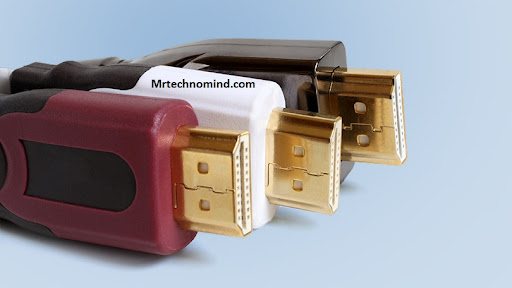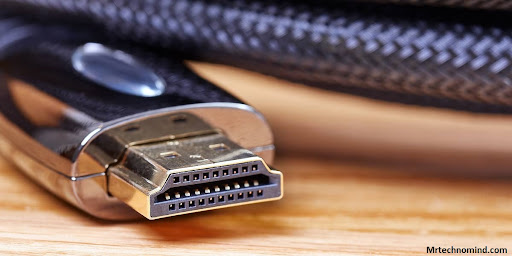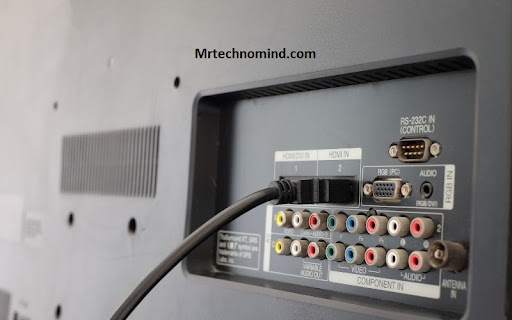What Is HDMI 2.1? Here’s Everything You Need to Know

If you’re an avid tech enthusiast, you must have heard of HDMI 2.1. The latest version of the High-Definition Multimedia Interface (HDMI) standard has existed since 2002.
In simple terms, HDMI is a cable that connects your devices to a TV or monitor and delivers high-quality audio and video signals.
So, what’s new with HDMI 2.1? Well, it promises to deliver even better picture quality with higher resolutions, faster refresh rates, and more colour depth. It also supports advanced gaming features like variable refresh rate (VRR), quick frame transport (QFT), and automatic low latency mode (ALLM).
In this article, we’ll look in-depth at HDMI 2.1 and see how it differs from previous standard versions.
What is Hdmi 2.1?
HDMI 2.1 is the latest version of HDMI, which stands for High-Definition Multimedia Interface. It’s a technology that transmits audio and video signals between devices, such as TVs, computers, and gaming consoles.
The HDMI 2.1 specification was released in November 2017, and it’s been slowly making its way into products since then.
The most significant improvement of HDMI 2.1 over previous versions is its increased bandwidth, or the amount of data it can transfer per second. Specifically, HDMI 2.1 supports up to 48 gigabits per second (Gbps), almost triple the bandwidth of HDMI 2.0b (18 Gbps). This allows for higher resolutions, faster refresh rates, and more colours.
For example, with HDMI 2.1 you can enjoy 4K video at up to 120 frames per second (fps), or even go up to 8K resolution at up to 60 fps.
You can also benefit from features like variable refresh rate (VRR), quick frame transport (QFT), quick media switching (QMS), and eARC (enhanced Audio Return Channel).
Overall, HDMI 2.1 represents a significant upgrade for anyone who wants the best audio and video quality from their devices. However, not all products support HDMI 2.1 yet, so checking compatibility before purchasing is essential.
In the next section, we’ll take a quick look at the history of HDMI and how it has evolved over time to reach this latest milestone in performance and functionality.
A Quick History of Hdmi

Like a bridge that connects two distant lands, HDMI has been the go-to interface for connecting audio and video devices for over a decade.
The first iteration of HDMI was introduced in 2002, which offered a significant upgrade from analogue connections like RCA cables. HDMI revolutionized the way we connect our entertainment devices, providing more bandwidth and allowing for higher resolutions.
With each new version of HDMI, improvements were made in terms of speed, bandwidth, and features. HDMI 1.4 brought 3D support and an Ethernet channel built into the cable.
Meanwhile, HDMI 2.0 introduced support for 4K resolution at higher frame rates and enhanced colour spaces. These advancements have allowed us to enjoy our content more clearly.
HDMI has come a long way since its introduction almost two decades ago, but it continues to evolve with each new version. The latest iteration is HDMI 2.1, which brings even more impressive features like support for higher resolutions up to 10K and refresh rates up to 120Hz. It also offers eARC (enhanced Audio Return Channel), which enables high-quality audio transmission between your TV and other devices.
So what do you need to take advantage of all these cutting-edge features? Stay tuned as we dive deeper into the world of HDMI 2.1 and explore what hardware you’ll need to unlock its full potential.
What Do You Need?

After learning about the history of HDMI, you might be wondering what you need to know about the latest version, HDMI 2.1. This new version of HDMI was released in 2017 and offers a range of improvements over its predecessors.
One of the main features of HDMI 2.1 is increased bandwidth, which allows for higher resolutions and refresh rates. For example, it supports resolutions up to 10K and refresh rates up to 120Hz. This is particularly useful for gamers or anyone who wants a more immersive viewing experience.
HDMI 2.1 also introduces new features like Dynamic HDR, which allows for better contrast and colour accuracy in each video frame. It also includes support for eARC (enhanced Audio Return Channel), which improves audio quality when using soundbars or other external audio devices.
Overall, if you plan on purchasing a new TV or other home theatre equipment shortly, it’s worth considering whether it supports HDMI 2.1. While not all devices have adopted this new standard, it’s becoming increasingly common and can significantly benefit your media consumption experience.
As we move into the next section on the main features of HDMI 2.1, keep these improvements in mind as we delve deeper into what this new standard offers for your home entertainment setup.
Main Features
One of the main features of HDMI 2.1 is increased bandwidth capacity. This means that it can transmit more data faster than previous versions of HDMI, allowing for higher-quality video and audio. Specifically, HDMI 2.1 has a maximum bandwidth of 48 Gbps, compared to 18 Gbps for HDMI 2.0.
Another important feature is support for higher resolutions and refresh rates. HDMI 2.1 can handle keys up to 10K and refresh rates up to 120Hz, which is especially important for gaming and other high-performance applications. It also supports Dynamic HDR, allowing more accurate colour representation in HDR content.
HDMI 2.1 also includes several new gaming-specific features, such as Variable Refresh Rate (VRR), Quick Frame Transport (QFT), and Auto Low Latency Mode (ALLM). VRR reduces screen tearing and stuttering by synchronizing the display’s refresh rate with the output from the graphics card. QFT reduces latency between input devices and exhibitions, while ALLM automatically switches to low-latency mode when you start playing a game.
Overall, HDMI 2.1 significantly upgrades over previous standard versions, providing higher-quality video, audio, and new gaming features. If you’re wondering whether your device supports HDMI 2.1, there are several ways to find out – read on to learn more about how to check if your device is compatible.
How Do I Tell if My Device Supports Hdmi 2.1?

As the famous saying goes, ‘out with the old, in with the new.’ HDMI 2.1 is the latest HDMI (High-Definition Multimedia Interface) cable standard version, allowing for higher bandwidth and faster data transfer rates. But how do you know if your device supports it?
First, check the specifications of your device to see if it mentions HDMI 2.1 compatibility. This information can usually be found in the product manual or on the manufacturer’s website. If you’re unsure where to look, try a quick internet search for your device model and ‘HDMI 2.1’ to see if any results come up.
Another way to tell if your device supports HDMI 2.1 is by looking at the actual ports on the device itself. HDMI 2.1 ports are typically labelled as such, so look for labels like ‘HDMI 2.1’ or ‘8K@60Hz’ (which refers to one of the key features of HDMI 2.1 – support for 8K resolution at a refresh rate of 60Hz).
If you still can’t determine whether your device supports HDMI 2.1, contact the manufacturer or consult a professional specialising in home theatre systems and A/V technology.
Now that you know if your device supports HDMI 2.1, you may wonder whether it’s worth upgrading to this new standard – mainly if your current setup works fine. In the next section, we’ll explore factors that may influence your decision and help you determine whether an upgrade is right for you.
Should I Upgrade?
If you’re considering upgrading to HDMI 2.1, there are a few factors to consider before making the switch.
First and foremost, it’s important to note that HDMI 2.1 is not backwards compatible with older HDMI versions. If you upgrade, you’ll need new cables, and all your devices must be HDMI 2.1 compatible.
Another factor to consider is whether or not your current setup would benefit from the upgrade. HDMI 2.1 offers several new features, including support for higher resolutions, faster refresh rates, and variable refresh rate technology.
If you have a TV or monitor that supports these features and plan to use them frequently, upgrading may be worth it. However, if you’re not planning on upgrading your display anytime soon or don’t have any devices that take advantage of the new features offered by HDMI 2.1, then upgrading may not make much sense now.
Whether or not you should upgrade to HDMI 2.1 depends on your specific needs and preferences regarding home entertainment systems. It’s essential to weigh the pros and cons carefully before making any decisions to ensure you maximise your investment in the long run.
Frequently Asked Questions
1. What Are the Differences Between Hdmi 2.0 and Hdmi 2.1?
As technology advances at an unprecedented rate, it’s no surprise that we’re seeing newer and better versions of HDMI cables.
While HDMI 2.0 was a significant upgrade from its predecessor, HDMI 2.1 takes things to a whole new level.
Increased bandwidth capabilities allow for higher resolutions and refresh rates, making it perfect for gamers and those who demand the best picture quality possible.
Additionally, HDMI 2.1 supports newer technologies, such as dynamic HDR and variable refresh rates, which can significantly enhance the viewing experience.
If you’re looking for the best possible connection between your device and TV or monitor, HDMI 2.1 is worth considering.
2. Can Hdmi 2.1 Support 8k Resolution?
Yes, HDMI 2.1 can support 8K resolution. With a bandwidth of up to 48Gbps, it can handle higher resolutions and refresh rates.
It also supports Dynamic HDR for improved colour and contrast and eARC for better audio transmission.
While HDMI 2.0 was limited to 4K at 60Hz, HDMI 2.1 has expanded capabilities that make it ideal for high-end gaming and home theatre setups.
3. What Kind of Cables Do I Need for Hdmi 2.1?
To ensure that you get the most out of your HDMI 2.1 setup, it’s essential to use the right cables.
HDMI 2.1 cables are designed to handle this technology’s high bandwidth requirements, allowing for features like 8K resolution and higher refresh rates.
These cables are backwards compatible with older HDMI versions, but if you want to take advantage of all that HDMI 2.1 has to offer, make sure you have a cable that supports this standard.
Look for cables labelled as ‘Ultra High Speed’ or ’48G,’ which should be able to handle all of your needs.
4. What Audio Formats Are Supported by Hdmi 2.1?
Did you know that HDMI 2.1 supports up to 32 channels of audio?
That’s right, this latest version of HDMI technology can deliver high-quality audio formats such as Dolby Atmos and DTS:X.
With HDMI 2.1, you can experience immersive surround sound like never before, making it the perfect choice for home theatres and gaming setups.
So if you’re looking for a cable that can handle the latest audio technologies, HDMI 2.1 is worth checking out!
5. Will Hdmi 2.1 Be Backwards Compatible With Older Hdmi Devices?
Yes, HDMI 2.1 will be backwards compatible with older HDMI devices.
You can use your existing HDMI cables and connectors to connect newer devices supporting HDMI 2.1.
However, remember that you can only take advantage of the features and capabilities of HDMI 2.1 if both the source device and the display device support it.
So, while you won’t need to replace all your existing cables and devices when upgrading to HDMI 2.1, you may still need to upgrade some components to utilise its benefits fully.
Conclusion
In conclusion, HDMI 2.1 is the latest HDMI specification that promises to revolutionize your home entertainment experience. With features like 8K resolution support, eARC (enhanced audio return channel), and variable refresh rate, it offers a significant upgrade over its predecessor, HDMI 2.0.
For instance, imagine you purchased a new 8K TV and wanted to play its latest games. With HDMI 2.0, you cannot take full advantage of its capabilities. However, with HDMI 2.1, you can enjoy gaming at up to 120 frames per second in stunning 8K resolution without lag or tearing.
Moreover, the eARC feature allows you to enjoy high-quality audio from compatible devices like soundbars or AV receivers without additional cables or switches.
Overall, if you are looking for the best picture and sound quality in your home entertainment setup and want to future-proof your investment, upgrading to HDMI 2.1 is worth considering.